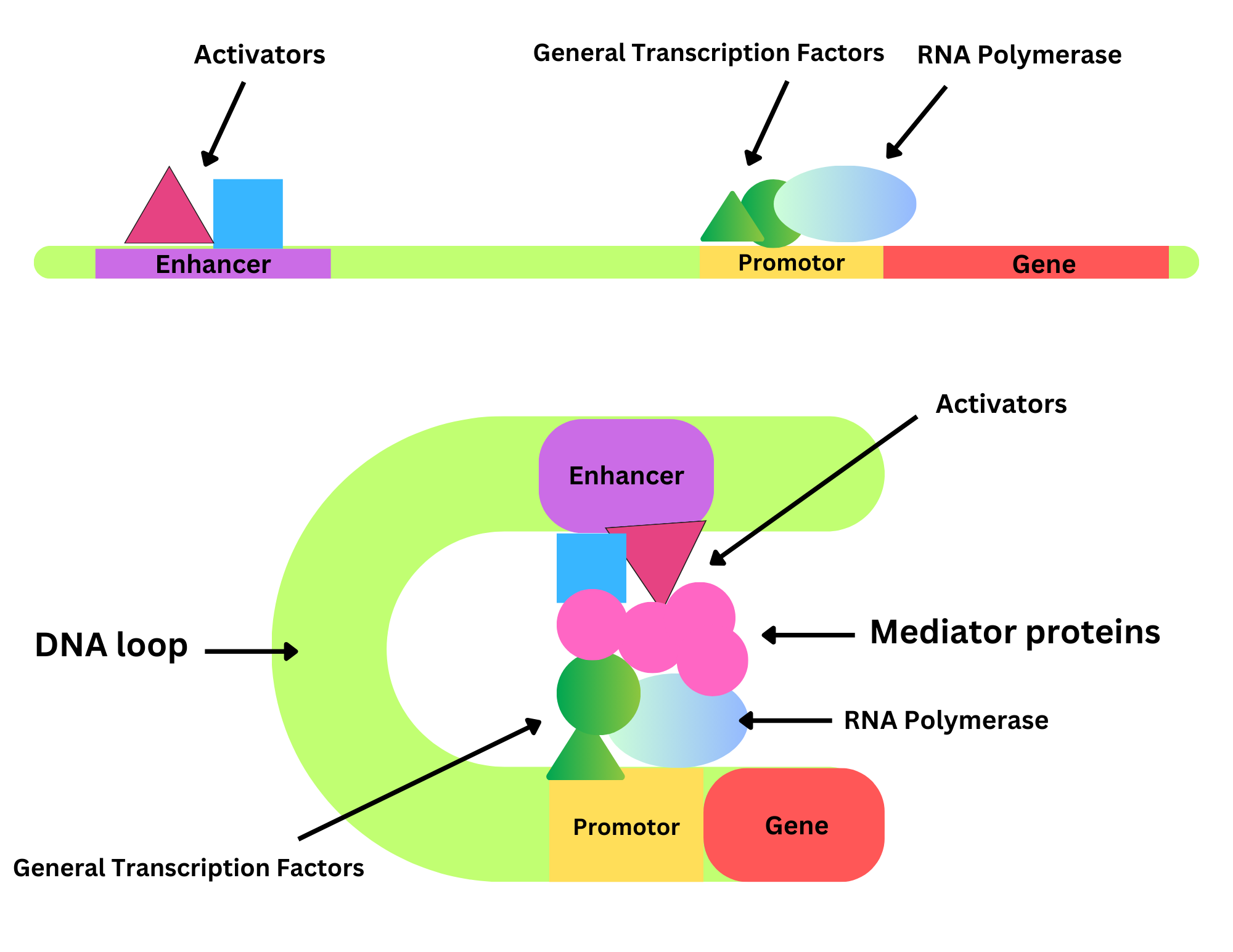Transcription:
During transcription, DNA duplicates specific segments ranging from a few hundred to many thousands of bases to create RNA, rather than the complete molecule.
Why transcription regulation is important?
Our bodies are composed of numerous unique cell types, each with its distinct shape and function. Transcription regulation plays a vital role in enabling these variations by controlling the activation of genes in each cell. This precise regulation allows genes to be turned on or off as needed, enabling cells to perform specific tasks in an energy-efficient manner. By producing only, the necessary proteins, this process conserves energy and ensures that all cell types contribute effectively to the overall health of the body.
Transcription Factors:
Any protein that controls transcription but is not an RNA polymerase subunit is referred to as a transcription factor. So basically, there are three major types of transcription factors i.e. general transcription factors, activators, and repressors (Minchin & Busby, 2013).
General transcription factors: General transcription factors bind to specific consensus sequences within the Promotor region. RNA polymerase and general transcription factors create a preinitiation complex that is competent for initiating transcription. Even without activators, the general transcription factors can maintain a basal level of transcription. Nevertheless, the preinitiation complex stands as the most critical stage in commencing transcription.
Activators: Gene-specific transcription factors are known as activators. Activators bind to the enhancer regions of the DNA (Shen, 2019).
Repressors: Eukaryotic repressors impede transcription by binding to particular DNA sequences. Certain repressors share the activator's DNA-binding domain but lack its activation domain, therefore sometimes repressors and activators engage in competition when it comes to binding to particular regulatory sequences, and they inhibit transcription. Additionally, active repression domains present on repressors inhibit transcription by interacting with general transcription factors.
Enhancers and formation of transcription initiation complex:
Regulatory sequences that govern expression in mammalian cells are primarily situated more than 10 kilobases away from the transcription start site. These sequences, known as enhancers, play a crucial role in gene expression by binding to transcription factors known as activators.
Through DNA looping, there will be an interaction between activators on enhancers, and general transcription factors and RNA polymerase at the promoter, ultimately leading to the formation of a final transcription initiation complex and subsequently the transcription (Cooper, 2000).

Difference between CDS and Exon regions of the DNA:
A DNA region that encodes a protein is referred to as a coding sequence, or CDS for short. A complete coding sequence contains all exon segments and encodes proteins. This sequence includes the start codon but lacks the stop codon. Exons are the gene sequence portions that remain in the mRNA after RNA splicing. Although not all exons encode a protein, there are untranslated regions (UTRs) located upstream (5') and downstream (3') of the coding exon regions. The 5'UTRs, or leader sequences, and 3'UTRs, or trailer sequences, are types of UTRs. These UTRs can be spliced like any other exon region or interrupted by introns (GOENOMICS, n.d.).
Introns can indeed appear in UTRs before or after the coding area. UTRs have their introns spliced out, but the remaining portion of the UTR is left intact and often plays significant roles in gene regulation. This is because the promoter region is enclosed by UTRs.
Transcription Factors Determination:
- Open NCBI and select "nucleotide" from the dropdown menu by clicking on the dropdown arrow.
- Enter the name of the gene or protein in the query section of the database.
- Click on the “RefSeq Transcripts” and select the first variant to obtain the mRNA transcript of the IL6 gene. This will allow us to access the DNA sequence from which the mRNA transcript is made, as the promoter region is located within or upstream of it.
- Click on "FASTA" to retrieve the transcript sequence in FASTA format.
- Store this sequence in a separate MS Word file by copying and pasting it.
- Remember to pay attention to the features section, which includes the CDS (Coding Sequence) section. This section contains the coding sequence that will be translated into proteins. The numbering (e.g., 64...702) indicates the number of nitrogenous bases, showing the start and end of the CDS region in the sequence. Make sure to click on "CDS" to highlight the CDS region in the sequence. Now click on “FASTA”
- In the stored .docx sequence, you will use the ctrl+F function to locate the CDS region. You will select a sequence from the beginning and end of the CDS and highlight the entire region, including the middle part.
- To learn more about the promoter sequence of the IL6 gene, simply navigate to the Eukaryotic Promoter Database (EPD) website, input "IL6" into the search field, and select the relevant result.
- When you click on IL6-1, the general information section and other sections will open up. In the general information section, you will find a sequence with nitrogenous bases written in both small and capital letters. The small letters represent the promoter region, while the capital letters indicate the gene.
- To retrieve the promotor sequence, simply choose "get sequence" from the "sequence retrieval tool" section and input nucleotides -499 to 0 or -499 to 100 as per your requirements. Then, duplicate the resulting sequence and place it into the Microsoft Word document.
- Visit the “PROMO TFBS” website, select “only human” in the 1st step for SelectingSpecies, and submit to accurately identify the transcription factors associated with this promoter. In 2nd step, once you've chosen "search sites", simply copy and paste the IL6 promoter region sequence into the search field and then click "submit." This action will reveal every transcription factor associated with that promoter region, along with the binding locations for each of them.
- To access the sequence on which a specific transcription factor will bind, simply right-click on the transcription factor's name and select "Open in new tab." For further information about a specific transcription factor, utilize the JASPER and TRANSFAC databases.
Conclusion: The transcription factors present in eukaryotic cells play a crucial role in controlling gene expression, ensuring proper cell function. Researchers can learn more about transcription regulation and its effects on health and illness by utilizing bioinformatics methods to predict transcription factors and understand transcription regulation.
References:
- Cooper, G. M. (2000). Regulation of transcription in Eukaryotes. The Cell - NCBI Bookshelf. https://www.ncbi.nlm.nih.gov/books/NBK9904/
- GOENOMICS. (n.d.). Expert Genome Data Analysis. https://goenomics.com/glossary.html#:~:text=A%20coding%20sequence%20(CDS)%20is,and%20excludes%20the%20stop%20codon.
- Minchin, S., & Busby, S. (2013). Transcription factors. In Elsevier eBooks (pp. 93–96). https://doi.org/10.1016/b978-0-12-374984-0.01552-7
- Shen, C. (2019). Gene expression: transcription of the genetic code. In Elsevier eBooks (pp. 59–86). https://doi.org/10.1016/b978-0-12-802823-0.00003-1


